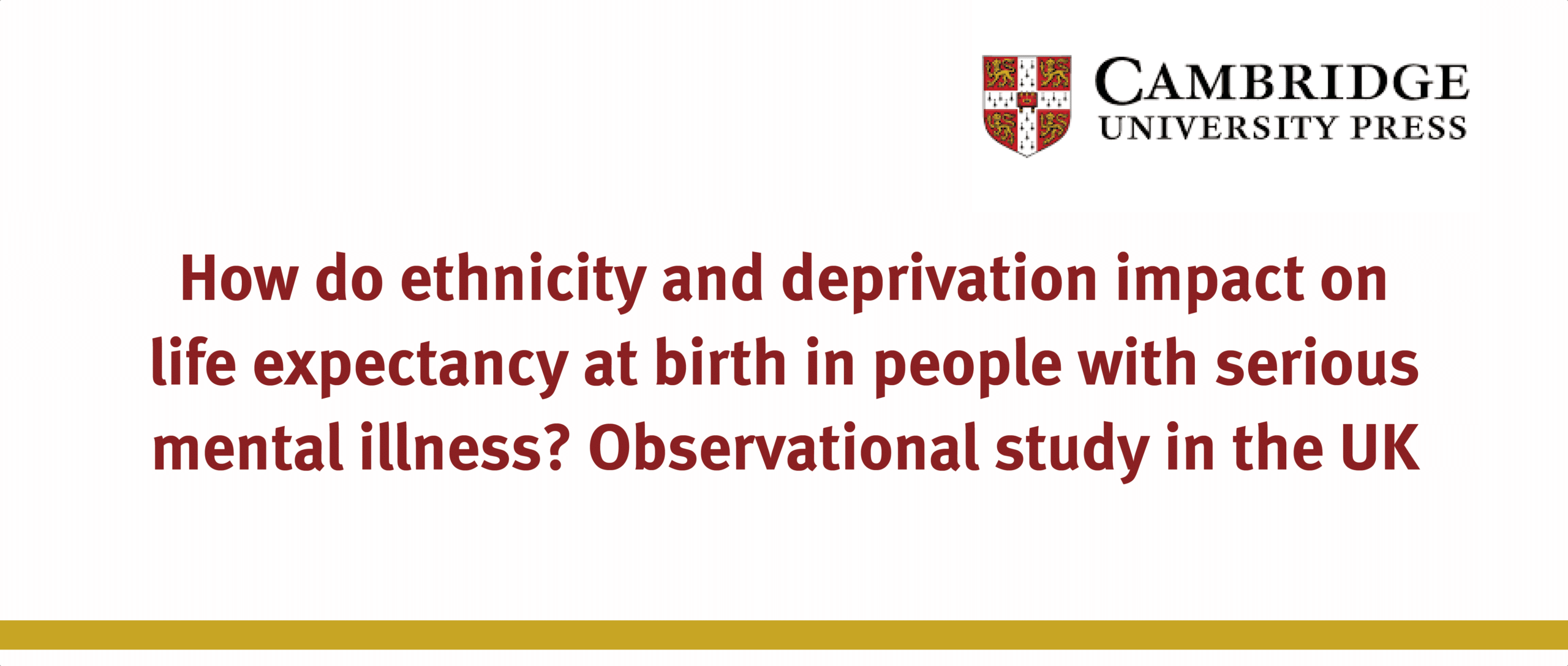Project Description
Cambridge University Press
Background. Across international contexts, people with serious mental illnesses (SMI) experience marked reductions in life expectancy at birth. The intersection of ethnicity and social deprivation on life expectancy in SMI is unclear. The aim of this study was to assess the impact of ethnicity and area-level deprivation on life expectancy at birth in SMI, defined as schizophrenia-spectrum disorders, bipolar disorders and depression, using data from London, UK.
Methods. Abridged life tables to calculate life expectancy at birth, in a cohort with clinicianascribed ICD-10 schizophrenia-spectrum disorders, bipolar disorders or depression, managed in secondary mental healthcare. Life expectancy in the study population with SMI was compared with life expectancy in the general population and with those residing in the most deprived areas in England.
Results. Irrespective of ethnicity, people with SMI experienced marked reductions in life expectancy at birth compared with the general population; from 14.5 years loss in men with schizophrenia-spectrum and bipolar disorders, to 13.2 years in women. Similar reductions were noted for people with depression. Across all diagnoses, life expectancy at birth in people with SMI was lower than the general population residing in the most deprived areas in England.
Conclusions. Irrespective of ethnicity, reductions in life expectancy at birth among people with SMI are worse than the general population residing in the most deprived areas in England. This trend in people with SMI is similar to groups who experience extreme social exclusion and marginalisation. Evidence-based interventions to tackle this mortality gap need to take this into account.
For more on this paper please visit the Cambridge University Press website.
Introduction
People with conditions such as schizophrenia or bipolar disorders experience marked reductions in life expectancy compared with the general population, ranging from 13 to 15 years (Hjorthøj, Stürup, McGrath, & Nordentoft, 2017) and in some contexts up to 20 years (Fekadu et al., 2018; Hjorthøj et al., 2017; Liu et al., 2017). This has been noted over time and is increasing (Lawrence, Hancock, & Kisely, 2013; Saha, Chant, & McGrath, 2007).
There is some indication of marked heterogeneity in life expectancy in these populations internationally, with the largest reductions in life expectancy reported in studies from sub-Saharan Africa (Hjorthøj et al., 2017). A similar reduction has been reported for severe unipolar depression, ranging from 10 to 14-year reduction in life expectancy, compared with the general population (Laursen, Musliner, Benros, Vestergaard, & Munk-Olsen, 2016).
It remains unclear whether life expectancy in serious mental disorders varies by ethnic group and deprivation. In the general population, there is concern that inequalities in population-level life expectancy are widening over time, with the largest reductions in life expectancy noted in the most deprived communities across the UK, relative to the least deprived (Bennett et al., 2018). The largest contributors to shortened life expectancy in the general population are from the same common preventable physical health conditions, such as respiratory disorders and ischaemic heart disease, that account for the majority of deaths in people with serious mental illness (SMI) (Bennett et al., 2018; Das-Munshi et al., 2017b).
Although the UK operates a system of universal access to healthcare it has been suggested that in deprived areas, access to healthcare may still be inequitable and may contribute to observed differences in life expectancy (Bennett et al., 2018). The interplay of these inequalities has not been previously assessed, despite a concern that access to care is also inequitable for people with SMI (Mitchell, Malone, & Doebbeling, 2018), fuelled by the stigma accorded to mental disorders (Thornicroft, 2018).
Common preventable conditions such as cardiovascular disease, type 2 diabetes mellitus and respiratory disorders account for the majority of deaths in people with serious mental disorders (Das-Munshi et al., 2017b; Saha et al., 2007). These are known to be elevated within certain ethnic minority groups, independent of the presence of serious mental illness (Health and Social Care Information Centre: HSIC, 2005). These conditions may become further elevated with the onset of mental illness (Das-Munshi et al., 2017a). Despite these important associations, there have been no studies which have examined differences in life expectancy at birth in SMI among ethnic minority groups (Hjorthøj et al., 2017).
We, therefore, aimed to assess variations in life expectancy at birth in a large ethnically diverse sample of people with schizophrenia-spectrum, bipolar disorders or depression, in contact with a secondary mental healthcare provider in London, UK. We included a sample of people with depression, as we considered that people in contact with secondary mental healthcare with depression represent the more ‘severe’ end of the spectrum since most ‘milder’ common mental disorders (including depression) are generally managed within primary care (Das-Munshi, Chang, Schofield, Stewart, & Prince, 2018). The sample of depressed individuals within this study may, therefore, represent complex cases referred to secondary mental healthcare for further management (Das-Munshi et al., 2018). We also sought to assess the moderating role of area-level deprivation and ethnicity on life expectancy at birth among men and women with SMI. ‘Serious mental illness’ was defined as including schizophrenia-spectrum, bipolar disordersas well as (severe) depression in contact with secondary care.
To read the full paper please click here.

